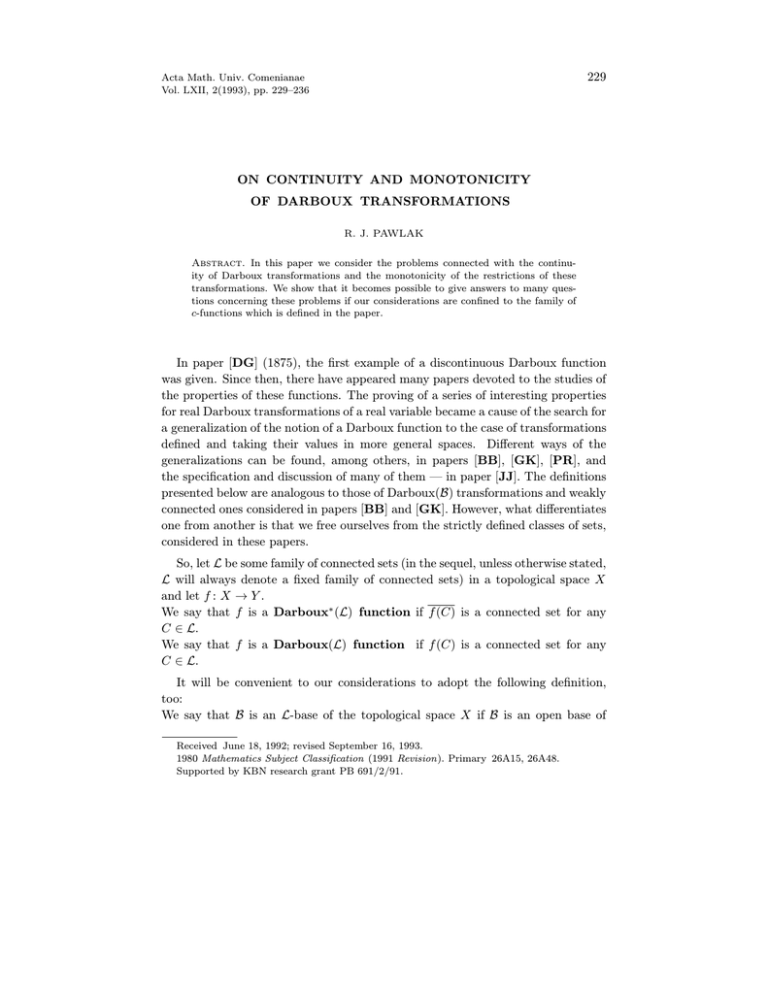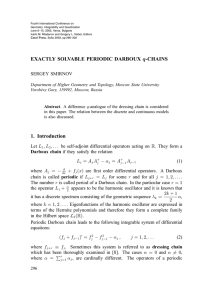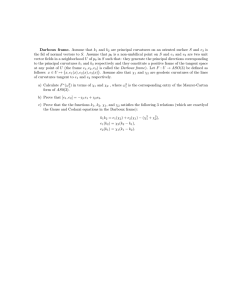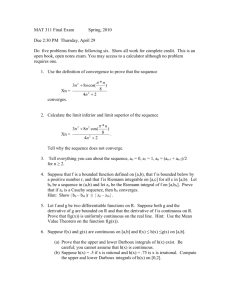229 ON CONTINUITY AND MONOTONICITY OF DARBOUX TRANSFORMATIONS
advertisement

229
Acta Math. Univ. Comenianae
Vol. LXII, 2(1993), pp. 229–236
ON CONTINUITY AND MONOTONICITY
OF DARBOUX TRANSFORMATIONS
R. J. PAWLAK
Abstract. In this paper we consider the problems connected with the continuity of Darboux transformations and the monotonicity of the restrictions of these
transformations. We show that it becomes possible to give answers to many questions concerning these problems if our considerations are confined to the family of
c-functions which is defined in the paper.
In paper [DG] (1875), the first example of a discontinuous Darboux function
was given. Since then, there have appeared many papers devoted to the studies of
the properties of these functions. The proving of a series of interesting properties
for real Darboux transformations of a real variable became a cause of the search for
a generalization of the notion of a Darboux function to the case of transformations
defined and taking their values in more general spaces. Different ways of the
generalizations can be found, among others, in papers [BB], [GK], [PR], and
the specification and discussion of many of them — in paper [JJ]. The definitions
presented below are analogous to those of Darboux(B) transformations and weakly
connected ones considered in papers [BB] and [GK]. However, what differentiates
one from another is that we free ourselves from the strictly defined classes of sets,
considered in these papers.
So, let L be some family of connected sets (in the sequel, unless otherwise stated,
L will always denote a fixed family of connected sets) in a topological space X
and let f : X → Y .
We say that f is a Darboux∗ (L) function if f (C) is a connected set for any
C ∈ L.
We say that f is a Darboux(L) function if f (C) is a connected set for any
C ∈ L.
It will be convenient to our considerations to adopt the following definition,
too:
We say that B is an L-base of the topological space X if B is an open base of
Received June 18, 1992; revised September 16, 1993.
1980 Mathematics Subject Classification (1991 Revision). Primary 26A15, 26A48.
Supported by KBN research grant PB 691/2/91.
230
R. J. PAWLAK
this space and, for any U ∈ B and any x, y ∈ U , there exists C ∈ L such that
x, y ∈ C ⊂ U .
Many problems studied by mathematicians in connection with the papers concerning Darboux transformations were related to the question of the continuity
and the monotonity of these functions. In order to make it possible to carry out
the studies on this subject, it was necessary to confine the considerations to some
narrower families of functions (e.g. [KU], [WD], [GZ], [HT], [PH] or [PJ]). In
this situation, it seems essential to find as wide a family of transformations as possible, whose properties would enable one to obtain results analogous (or stronger)
to those included in the papers cited above. To accomplish this aim, we shall adopt
the following definition (the symbol M d stands for the derived set of a set M ).
Definition. Let f : X → Y where X and Y are arbitrary topological spaces.
We say that f is a c-function if, for any subset A of the space X and each x ∈ Ad ,
there exists a set B ⊂ A such that x ∈ B d and (f (B))d ⊂ {f (x)}.
Throughout the paper, we adopt the classical symbols and notations. The
adoption of the way of defining a Darboux function justifies the adoption of certain
modifications of the notations applied, among others, in papers [GK] and [GZ].
So, let L be some family of connected sets in X and let f be a function defined
on X. Then YL (f ) = {α ∈ f (X) : f −1 (α) ∈ L} and SL (f ) = f −1 (YL (f )). Of
course, if L is the family of all connected subsets (continua) of the space X, and
SL (f ) = X, then f is weakly monotone (Morrey monotone) ([GK]). We say that
f : X → Y is L-pseudo monotone if f (X) is a connected set and, for any α ∈ Y ,
any x, y ∈ f −1 (α) and any neighbourhoods U, V and W of the points x, y and α,
respectively, there exists a set C ∈ L such that U ∩ C 6= ∅ 6= V ∩ C and f (C) ⊂ W .
Of course, every L-weakly monotone function (i.e. such that SL (f ) = X) is Lpseudo monotone. There exist, however, continuous c-functions being C-pseudo
monotone and K-pseudo monotone which are not C-weakly monotone (C — the
family of all connected sets, K — the family of all continua).
We say that a function f : X → Y is relatively proper if f −1 (K) is a compact
set for any compact set K ⊂ Y ([GK], [GZ]).
As far back as the XIXth century, many mthematicians thought the Darboux
property to be equivalent to the continuity of functions ([BA, Chapter I]). Later,
additional conditions under which Darboux transformations (also in more abstract
spaces) are continuous were sought for (e.g. [HT], [JJ], [KU], [PH], [WD]). These
considerations comprised mainly metric spaces because, in the case of topological
ones, the situation became considerably complicated. Therefore it seems essential
to ask about the possibility of obtaining results analogous (or stronger) to those
contained in the papers cited above, in a more general case.
A partial solution to this question is the following
DARBOUX TRANSFORMATIONS
231
Theorem 1. Let X be a Hausdorff space with an L-base and let Y be a locally compact space; moreover, let X and Y be first-countable. Then a c-function
f : X → Y is Darboux∗ (L) if and only if f is continuous.
Proof. The sufficiency of the above condition is obvious.
Necessity. Suppose to the contrary that a c-function f is Darboux∗ (L) and
there exists a point t0 ∈ X such that f is discontinuous at t0 .
Let Z be a compact set included in Y such that f (t0 ) ∈ Int (Z) and
(1)
f (U ) \ Z 6= ∅
for any neighbourhood U of f (t0 ).
Let P be a compact set such that f (t0 ) ∈ Int (P ) ⊂ P ⊂ Int (Z). Assume that B
is an L-base of X, and
B(t0 ) = {U ∈ B : t0 ∈ U }.
We infer that
(2)
f (U ) ∩ (V \ P ) 6= ∅ for any U ∈ B(t0 ) and for any open set V ,
such that P ⊂ V ⊂ Int (Z).
Indeed. Assume that (2) does not take place. Then there exist U ∈ B(t0 ) and
an open set V such that P ⊂ V ⊂ Int (Z) and f (U ) ∩ (V \ P ) = ∅. By virtue
of (1), there exists x ∈ U such that f (x) ∈
/ Z. Let C ∈ L be such that t0 , x ∈ C.
Therefore f (C) ∩ (V \ P ) = ∅ and f (C) ∩ P 6= ∅ 6= f (C) \ V . This means that f (C)
is not a connected set, which contradicts our assumption that f is Darboux∗ (L).
So, (2) is true.
Let Ξ = {(U, V ) : U ∈ B(t0 ) ∧ P ⊂ Int(V ) = V ⊂ Int(Z)}. Define the directing
relation ≤ in Ξ in t he following way:
(U, V ) ≤ (U 0 , V 0 ) ⇔ U ⊃ U 0 ∧ V ⊃ V 0 .
Now, we define the net {xξ }ξ∈Ξ in the following way: for each ξ = (U, V ) ∈ Ξ,
let xξ denote an arbitrary element of the set U satisfying f (xξ ) ∈ V \ P (by (2),
it is possible).
Let α0 be a cluster point of the net {f (xξ )}ξ∈Ξ . We shall show that
(3)
α0 ∈ P \ Int(P ).
Let us first prove that α0 ∈ P . Assume to the contrary that α0 ∈
/ P . Thus, by
the regularity of Y , there exist open sets V0 and V1 such that P ⊂ V0 ⊂ Int (Z),
α0 ∈ V1 and V0 ∩ V1 = ∅. Put ξ0 = (U0 , V0 ) where U0 is an arbitrary set from
B(t0 ). It is easy to see that f (xξ ) ∈ V0 for each ξ ≥ ξ0 , which contradicts the
fact that α0 is a cluster point of {f (xξ )}ξ∈Ξ . This proves that α0 ∈ P . Note
that α0 ∈
/ Int P because, in the opposite case, by the definition of {xξ }ξ∈Ξ , there
232
R. J. PAWLAK
exists a neighbourhood of α0 disjoint from {f (xξ ) : ξ ∈ Ξ}, which is impossible.
Condition (3) is proved.
By virtue of (3), we have
α0 ∈
/ {f (xξ ) : ξ ∈ Ξ}.
Let B ∗ (t0 ) be a countable open base of X at t0 and let R(α0 ) be a countable
base of Y at α0 consisting of open sets such that their closures are included in
Int (Z).
Write the above bases down in the following way:
B ∗ (t0 ) = {U1 , U2 , . . . },
R(α0 ) = {V1 , V2 , . . . }.
We may assume that V1 ⊃ V2 ⊃ . . . .
Let n be a fixed positive integer. From the above cosiderations we infer that
there exists a point
zn ∈ (Un \ {t0 }) ∩ f −1 (Vn \ {α0 }).
Put A1 = {zn : n = 1, 2, . . . }. Of course, t0 ∈ Ad1 . So, let B be an arbitrary
subset of A1 such that t0 ∈ B d . Thus there exists a sequence {kn }∞
n=1 consisting
of positive integers such that zkn ∈ B (for n = 1, 2, . . . ). It is easy to see that
α0 ∈ (f (B))d and (by (3) and the fact that f (t0 ) ∈ Int (P )) α0 6= f (t0 ), which
contradicts the assumption that f is a c-function.
The contradiction obtained ends the proof.
In paper [GK], the following problem was posed: under what assumptions with
respect to X and f is a connected function f : X → R (where R denotes the set
of all real numbers) monotone (i.e. the preimage of an arbitrary connected set is
a connected set) or weakly monotone (i.e. each level f −1 (α) is a connected set)
relatively to the closure of the union of all connected levels? Some partial answer
can be found in [GZ], [PJ], [PRJ], [RP]. The adoption of our definitions and
notations allows one to write this problem down in a little more general form:
Under what assumptions with respect to X and f is a Darboux (L) function
f : X → R monotone or weakly monotone relatively to SL (f )?
The theorem below constitutes a partial answer to the problem thus formulated.
It deserves attention that, unlike the theorems in the works cited above, we assume
relatively little about the domains of the transformations considered and adopt the
weakest version of the Darboux property.
In the sequel, we shall assume that the family L contains all continua and
possesses the following property: for any A ∈ L, if x ∈ A, then A ∪ {x} ∈ L.
233
DARBOUX TRANSFORMATIONS
Theorem 2. Let X be a T5 -space with an L-base B and let f : X → R be a
c-function Darboux(L), relatively proper and L-pseudo monotone. Then f SL (f ) is
weakly monotone.
Proof. Assume to the contrary that:
(i) there exists α ∈ R such that f −1 (α) ∩ SL (f ) is a nonempty set which is
not connected.
By the above, we may show that:
(ii) there exists ε > 0 such that
either (α − ε, α) ∩ YL (f ) = ∅ or (α, α + ε) ∩ YL (f ) = ∅.
Indeed, suppose that (ii) does not take place. Then there exist two sequences
∞
+ ∞
{α−
n }n=1 , {αn }n=1 ⊂ YL (f ) such that
−
−
+
+
+
lim α−
n = α = lim αn and αi < αi+1 , αi > αi+1
n→∞
n→∞
(i = 1, 2, . . . ).
Let n be a fixed positive integer. We shall show that
(4)
+
f −1 ([α−
n , αn ]) is the continuum.
First, we shall prove that
(5)
+
f −1 ([α−
n , αn ])
is closed.
+
Consider x ∈ X \ f −1 ([α−
n , αn ]). We shall now show that:
(6)
−1
(α+
there exists U ∈ B such that x ∈ U and U ∩ (f −1 (α−
n)∪f
n )) = ∅ .
−1 (α+ ). AsSuppose that (6) does not hold. Then either x ∈ f −1 (α−
n ) or x ∈ f
n
−1
sume, for instance, that x ∈ f −1 (α−
(α−
)
∪
{x}
∈
L,
which
contradicts
n ). Thus f
n
the asumption that f is Darboux(L). The contradiction obtained proves (6).
By virtue of the assumption that f is Darboux(L) and by (6), we may observe
+
that x ∈
/ f −1 ([α−
n , αn ]), which proves (5) (by the free choice of x).
We shall now show that:
(7)
+
the set f −1 ([α−
n , αn ]) is connected.
+
−1
+
Suppose that f −1 ([α−
([α−
n , αn ]) is not connected; then f
n , αn ]) = P ∪ Q
where P and Q are nonempty, closed and disjoint sets. Then, according to the
L-pseudomonotonicity of f , f (P ) ∩ f (Q) = ∅. Now, we shall show that
(8)
f (P ) ∩ f (Q) = ∅ .
234
R. J. PAWLAK
Indeed, in the opposite case, there exists βn ∈ f (P ), (n = 1, 2, . . . ) and β ∈
f (Q) such that β = lim βn and βn 6= βm for n 6= m. Let pn ∈ P ∩ f −1 (βn )
n→∞
for n = 1, 2, . . . . From the assumption that f is relatively proper and from the
closedness of P we infer that there exists a subnet {qσ }σ∈S of {pn }∞
n=1 converging
d
to some q0 ∈ P . It is easy to see that q0 ∈ {qσ : σ ∈ S} . Let P1 be an
arbitrary subset of {qσ : σ ∈ S} such that q0 ∈ P1d . Therefore f (P1 ) contains some
d
subsequence of {βn }∞
n=1 and, consequently, β ∈ (f (P1 )) . Of course, β 6= f (q0 ),
which is impossible because f is a c-function. The contradiction obtained proves
equality (8).
Similarly we can show that f (P ) ∩ f (Q) = ∅.
+
Moreover, we infer that [α−
n , αn ] = f (P ) ∪ f (Q). This situation is impossible
according to (8) and the above remark. This contradiction ends the proof of (7).
By virtue of (5), (7) and the fact that f is relatively proper, we infer that (4)
takes place.
∞
T
+
So, by (4), f −1 (α) =
f −1 ([α−
n , αn ]) is a continuum ([ER, Corollary 6.1.2,
n=1
p. 437]), which contradicts (i ). The contradiction obtained ends the proof of (ii).
By virtue of (i), we have f −1 (α) ∩ SL (f ) = T ∪ D where T and D are separated
sets. Let UT and UD be open sets such that T ⊂ UT , D ⊂ UD and UT ∩ UD = ∅
([ER, Theorem 2.1.7, p. 97]). Moreover, let t0 ∈ T and d0 ∈ D. Of course,
t0 , d0 ∈
/ SL (f ), so there exist nets {tσ }σ∈Σ and {dδ }δ∈∆ consisting of elements of
SL (f ), such that t0 = lim tσ and d0 = lim dδ . We shall show that
σ∈Σ
(9)
δ∈∆
lim f (tσ ) = α = lim f (dδ ).
σ∈Σ
δ∈∆
Since the proofs of both the equalities are analogous, therefore we shall show
only the first of them.
Assume to the contrary that α is not a limit of the net {f (tσ )}σ∈Σ . Thus
there exists a real number η > 0 such that, for each σ0 ∈ Σ, there exists σ ≥ σ0
such that f (tσ ) ∈
/ (α − η, α + η). Put Σ0 = {σ ∈ Σ : f (tσ ) ∈
/ (α − η, α + η)}.
Of course, {f (tσ )}σ∈Σ0 is a subnet of {f (tσ )}σ∈Σ . Consider the following sets:
Σ00 = {σ ∈ Σ0 : f (tσ ) ≤ α − η}, Σ000 = {σ ∈ Σ0 : f (tσ ) ≥ α + η}.
Let us remark that ( we assume that Σ is directed by ≤)
either,
(10)
for each σ0 ∈ Σ0 , there exists σ00 ∈ Σ00 such that σ00 ≥ σ0
or,
for each σ0 ∈ Σ0 , there exists σ000 ∈ Σ000 such that σ000 ≥ σ0 .
Assume, for instance, that (10) takes place for Σ00 . Thus Σ00 is a directed set
and {tσ }σ∈Σ00 is a subnet of {tσ }σ∈Σ and, of course, {f (tσ )}σ∈Σ00 is a subnet of
{f (tσ )}σ∈Σ .
DARBOUX TRANSFORMATIONS
235
Consider the following cases:
10 . ξ − = sup{f (tσ ) : σ ∈ Σ”} ∈ {f (tσ ) : σ ∈ Σ”}.
Then ξ − ∈ YL (f ) and, as is easy to show, f −1 ((ξ − , +∞)) is a neighbourhood of
/ f −1 ((ξ − , +∞)) for any σ ∈ Σ”, which leads to a contradiction.
t0 such that tσ ∈
20 . ξ − = sup{f (tσ ) : σ ∈ Σ”} ∈
/ {f (tσ ) : σ ∈ Σ”}.
Let Π = {(U, n) : U ∈ B ∧ t0 ∈ U ∧ n ∈ N} (N denotes the set of all positive
integers ). Let us define the relation directing Π as follows:
(U, n) (V, m) ⇔ U ⊃ V ∧ n ≤ m.
Define a net {ξp }p∈Π in the following way: for each p = (U, n) ∈ Π, give ξp such
that ξp ∈ U and f (ξp ) ∈ (ξ − − n1 , ξ − ). We infer that
t0 = lim ξp
p∈Π
and ξ − = lim f (ξp ).
p∈Π
Of course, t0 ∈ {ξp : p ∈ Π}d . Let B1 be an arbitrary subset of {ξp : p ∈ Π}
such that t0 ∈ B1d . We may notice that f (B1 )∩(ξ − − n1 , ξ − ) 6= ∅ (for n = 1, 2, . . . ),
which means that ξ − ∈ f (B1 )d , which contradicts the fact that f is a c- function.
The proof of (9) is thus finished.
So, let W be an arbitrary element from B containing d0 and such that W ⊂ UD .
According to (ii), assume (α, α + ε) ∩ YL (f ) = ∅. By (9), one may assume that
f (tσ ) < α for σ ∈ Σ and infer that f (W ) is a nondegenerate interval such that
(α − ε, α) ∩ f (W ) 6= ∅. Consequently, there exists σ0 ∈ Σ such that, for each
σ ≥ σ0 , f (tσ ) ∈ f (W ). Since f −1 (f (tσ )) is a connected set non-disjoint from UT
and UD , there exists hσ ∈ f −1 (tσ ) \ (UT ∪ UD ), (σ ≥ σ0 ). By the fact that f is
relatively proper, there exists a cluster point h0 ∈ X of {hσ }σ≥σ0 . Let {gσ∗ }σ∗ ∈Σ∗
be a subnet of {hσ }σ≥σ0 , converging to h0 . Of course, h0 ∈
/ UT ∪ UD , and so,
h0 ∈
/ f −1 (α) (because h0 ∈ SL (f )). Let Z = {gσ∗ : σ∗ ∈ Σ∗ }. Therefore h0 ∈ Z d .
Let S be an arbitrary subset of Z such that h0 ∈ S d .
Now, we shall show that
1
(11)
f (S) ∩ α − , α 6= ∅ for any n ∈ N.
n
First, we shall prove that
(12)
f (h0 ) > α.
Indeed, in the opposite case, between f (h0 ) and α there lies some element
τ ∈ YL (f ). Thus, as is easy to see, f −1 ((−∞, τ )) is a neighbourhood of h0 , and
this is impossible because h0 is a cluster point of {hσ }σ≥σ0 .
Let us return to the proof of (11). Assume that there exists n0 such that
f (S) ∩ (α − n10 , α) = ∅. Thus, by (12), it is easy to indicate a neighbourhood of
h0 which is disjoint from S, which is impossible.
From (11) we infer that α ∈ f (S)d , which contradicts the fact that f is a
c-function.
Thus the proof of Theorem 2 is finished.
236
R. J. PAWLAK
References
[BA] Bruckner A. M., Differentiation of Real Functions, Springer Verlag, 1978.
[BB] Bruckner A. M. and Bruckner J. B., Darboux transformations, Trans. Amer. Math. Soc.
128 (1967), 103–111.
[DG] Darboux G., Memoire sur les fonctions discontinues, Ann. Sci. Scuola Norm. Sup. 4
(1875), 57–112.
[ER] Engelking R., General Topology, Warszawa, 1977.
[GK] Garg K. M., Properties of connected functions in terms of their levels, Fund. Math. 47
(1977), 17–36.
[GZ] Grande Z., Les ensambles de niveau et la monotonic d’une fonction, Fund. Math. 102
(1979), 9–12.
[HT] Hamlett T. R., Compact maps, connected maps and continuity, J. London Math. Soc. 10
no. 2 (1975), 25–26.
[JJ] Jȩdrzejewski J. M., Wlasności funkcji zwia̧zane z pojȩciem spójności, Acta Univ. Lodz.
(1984), 1–84.
[KU] Klee V. L. and Utz W. R., Some remarks on continuous transformations, Proc. Amer.
Math. Soc. 5 (1954), 182–184.
[PH] Pawlak H., On some condition equivalent to the continuity of closed functions, Dem.
Math. 17.3 (1984), 723–732.
[PJ] Pawlak H. and Pawlak R.J., On some properties of closed functions in terms of their
levels, Comm. Math. 26 (1986), 81–87.
[PR] Pawlak R.J., On Zahorski classes of functions of two variables, Rev. Roum. de Math.
Pures et Appl. 35.1 (1990), 53–71.
[PRJ]
, On the continuity and monotonicity of restrictions of connected functions, Fund.
Math. 114 (1981), 91–107.
[RP] Pawlak R. J. and Rychlewicz A., On K. M. Garg’s problem in respect to Darboux functions, Acta Univ. Lodz. Folia Math. 4 (1991), 91–107.
[WD] White D. J., Functions preserving compactness and connectedness, J. London Math. Soc.
3 (1971), 767–768.
R. J. Pawlak, Institute of Mathematics, Lódż University, Banacha 22, 90-238 Lódż, Poland




